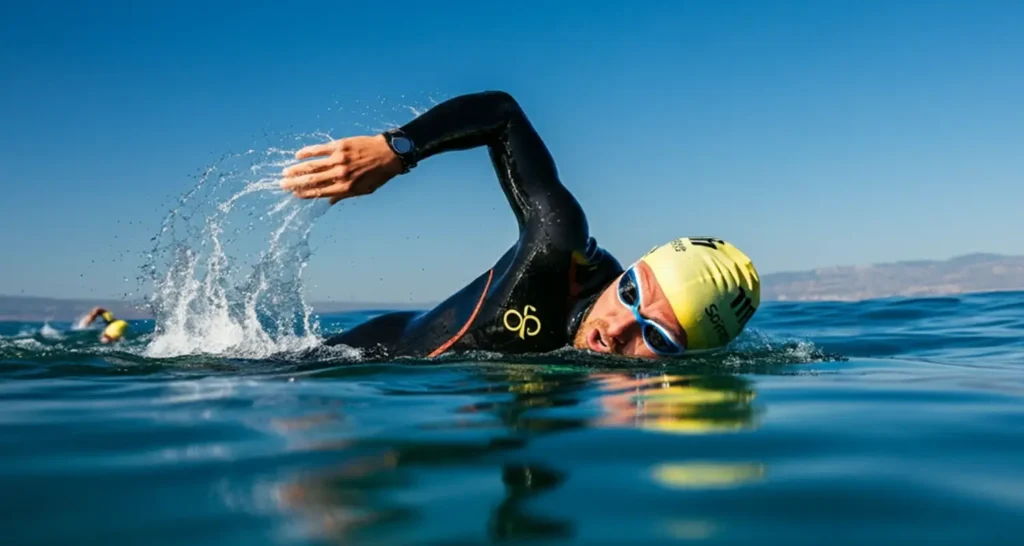Ever feel “flat” in the water during freestyle, struggling to generate power or maintain rhythm? The secret to unlocking effortless speed lies in body roll and core rotation—the foundation of a streamlined, powerful stroke. Enter the Domino Swim Stroke, a transformative drill designed to amplify these skills. Unlike superficial tutorials, this guide dives deep into the mechanics, benefits, and actionable steps to master the Domino Drill, making it the ultimate resource for swimmers and triathletes alike.

What Is the Domino Swim Stroke?
The Domino Swim Stroke (or Domino Drill) is a freestyle technique drill that exaggerates body roll and sequential rotation to improve core engagement, timing, and stroke efficiency. Its name comes from the “domino effect” of movements: rolling from one side to the other in a smooth, controlled chain, much like falling dominoes.
Key Features:
- Exaggerated Rotation: Teaches swimmers to rotate hips, torso, and shoulders in unison.
- Core-Driven Movement: Forces reliance on core muscles rather than arms or shoulders.
- Kickboard Integration: Often performed with a kickboard to isolate upper-body mechanics.
Why It’s Not a Stroke: It’s a drill, not a competitive stroke. Its purpose is to build muscle memory for efficient freestyle.
Why Body Roll and Core Rotation Matter in Freestyle
Body roll isn’t just for aesthetics—it’s biomechanically essential:
- Reduces Drag: Rotating minimizes frontal resistance, letting you glide like a torpedo.
- Lengthens Stroke: Rotation extends your reach, maximizing propulsion per stroke.
- Engages Powerhouse Muscles: Core and latissimus dorsi drive rotation, sparing smaller shoulder muscles.
- Simplifies Breathing: Natural head alignment during rotation eases breath timing.
Benefits of the Domino Drill
- Enhanced Body Awareness: Feel the “domino effect” of sequential rotation.
- Stronger Core Activation: Trains the core to initiate and control rotation.
- Smoother Freestyle Rhythm: Syncs arm recovery with hip-driven rotation.
- Injury Prevention: Reduces shoulder strain by leveraging larger muscle groups.
How to Perform the Domino Drill: Step-by-Step
Visual Demo: [Embed a video demonstrating the drill here]
Equipment: Kickboard (optional for beginners), swimsuit, goggles.
1: Starting Position
- Float prone (face down) with arms extended, holding a kickboard at arm’s length.
- Keep legs straight with a gentle flutter kick.
2: Initiate the Roll (Right Side)
- Engage your core and rotate hips/torso to the right until you’re nearly on your side.
- Keep your head aligned with your spine; avoid lifting it.
- Your right arm remains extended forward; the left arm rests by your hip.
3: Kick and Breathe (Right Side)
- Maintain a steady flutter kick.
- Breathe: Turn your head slightly to the right if comfortable (beginners can skip breathing initially).
4: Roll to the Left Side
- Reverse the motion: Rotate hips/torso to the left smoothly.
- Transition without jerking—imagine a domino tipping fluidly.
5: Kick and Breathe (Left Side)
- Repeat the kick and breathing on the left side.
6: Continuous Domino Roll
- Alternate sides every 3–5 seconds, focusing on rhythm and control.
7: Key Focus Points
- Core-Driven Rotation: Initiate rolls from your hips, not shoulders.
- Head Position: Eyes down; rotate your head with your body during breaths.
- Smooth Transitions: Avoid “snapping” between sides.
Common Mistakes to Avoid
- Over-Rotation: Rolling past 90° disrupts alignment. Fix: Aim for 45–60° rotation.
- Lifting the Head: Creates drag and sinks hips. Fix: Pretend you’re “looking through a tunnel”.
- Disconnected Kick: Legs stop during rotation. Fix: Maintain a steady, gentle flutter.
- Arm Flopping: Letting the non-extended arm dangle. Fix: Keep it glued to your side.
Drill Progressions & Variations
Beginner:
- Practice vertical rotation drills in shallow water (no kickboard).
Intermediate:
- Use fins to focus on rotation without losing momentum.
Advanced:
- Integrate the drill into full freestyle: Rotate deeply every 3–4 strokes.
Variation: Domino Kick Drill
- Emphasize leg drive: Rotate sides while performing a powerful dolphin kick.
Integrating the Domino Drill into Workouts
- Warm-Up: 4x50m Domino Drill (focus on rotation).
- Technique Sets: 8x25m Domino + 50m Freestyle (apply rotation).
- Cool-Down: 2x50m Slow Domino Drill with breath control.
Who Should Use This Drill?
- Beginners: Learn proper rotation early.
- Intermediate Swimmers: Refine stroke efficiency.
- Triathletes: Conserve energy for biking/running.
- Shoulder-Injury-Prone Swimmers: Reduce strain.
FAQ
2–3x weekly for 4–6 weeks to see technique improvements.
Yes! Advanced swimmers often use a streamlined position instead.
Focus on freestyle first, but the core principles apply to all strokes.
Conclusion
The Domino Swim Stroke isn’t just a drill—it’s a game-changer for freestyle efficiency. By mastering sequential rotation and core engagement, you’ll glide farther, breathe easier, and swim faster with less effort.

